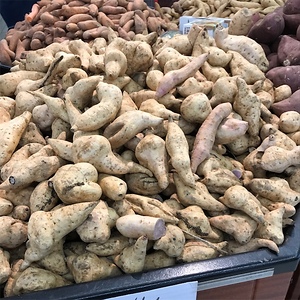


Okinawan Yams
Estimated Inventory, 30 lbs : 3.49
This item was last sold on : 07/14/25
Description/Taste
Okinawan yams are medium to large in size and are ovate and tubular in shape with slightly tapered ends. The skin is rough and uneven and has a buff beige hue with spots and lines of earthy brown. The flesh is violet purple in color, sometimes marbled with white and lavender striations and offers a heavily starchy texture, a characteristic common of a true yam but uncommon of sweet potato “yam.” When cooked, Okinawan yams offer an earthy yet incredibly sweet flavor and a slightly dry but velvety texture. The young leaves and shoots of the Okinawan yam plant are edible as well and are known as kandaba in Okinawa.
Seasons/Availability
Okinawan yams are available year-round, with peak season in the late summer through late spring.
Current Facts
Okinawan yams, botanically classified as Ipomoea batatas, are a dicotyledonous plant and are a part of the Convolvulaceae or morning glory family. Also known as the Okinawan sweet potato, Okinawan yams are botanically speaking a sweet potato rather than a true yam. In the United States, all non-white fleshed sweet potatoes are typically sold as yams even though botanically they are not. In recent years purple-fleshed potatoes such as the Okinawan yam have experienced a surge in popularity as they have been recognized for their exceptionally nutritious nature by a multitude of experts on nutrition and diet such as the American Heart Association, the Center for Science in the Public Interest, and the American Cancer Society.
Nutritional Value
Okinawan yams are rich in vitamin A in the form of beta-carotene, vitamin C, manganese, dietary fiber, and vitamin B6. Additionally, they offer magnesium, potassium, carotenoids, iron, protein, calcium, and naturally occurring sugars.
Applications
Okinawan yams are best suited for cooked applications such as baking, roasting, steaming, boiling, or mashing and can be cooked with the skin on or off. Okinawan yams retain their vibrant hue when cooked making them ideal for use in applications that highlight their coloring. They can be substituted in most recipes that call for sweet potatoes such as gnocchi, sweet potato pie, and sweet potato fries. They can also be baked, or roasted whole with the skin on and then served as is or mashed. Halved or cut into chunks they can be steamed or boiled. When sliced into sticks or rounds and then roasted or fried, Okinawan yams make an excellent side dish, or snack food served alongside dips. The young leaves of the Okinawan yam plant are also consumed and used commonly in miso soup or as a side dish. Their flavor is complemented by citrus zest, maple syrup, brown sugar, butter, sage, chipotle, cinnamon, nutmeg, bonito broth, bitter melon, pork, and fish. Okinawan yams will keep up to a couple of weeks when stored in a cool, dark, and dry location.
Ethnic/Cultural Info
The Okinawan yam made up the bulk of the Okinawan population’s diet from the 1600’s all the way up until 1960. The long-term consumption of these low calorie, nutrient-rich sweet potatoes are believed to be at least partially responsible for a large population of centenarians and older Okinawans that have not experienced many of the age-related diseases common around the world. In Japan, the Okinawan yam is used not only as food but also as a natural method to help reduce symptoms of diabetes, anemia, and hypertension.
Geography/History
Sweet potatoes were first introduced to Okinawa around 1605 via China and were quick to become widely cultivated. Its widespread growth would subsequently create a population boom as it eliminated a large degree of hunger-related deaths that had plagued Okinawa previously. Soon after the sweet potatoes made their way to Japan, they were officially given the name Okinawan sweet potato or Kara-mmu. Like in many countries, the sweet potato was originally known as a food of poverty and consumed more so out of need than for the pleasure of eating. During the past century, the Okinawan yam and other purple fleshed types have been touted as a superfood which has proved to increase the demand for them in developed countries around the globe. In Okinawa, while consumption is no longer done so purely out of necessity to survive, they are still enjoyed there for their flavor and nutritional benefits and can be found at local markets in Japan and at select grocers in the United States.
Featured Restaurants
Restaurants currently purchasing this product as an ingredient for their menu.
| Sushi Tadokoro | San Diego CA | 619-347-2792 |
| Lumi | San Diego CA | 619-955-5750 |
| The Barista Botanist | San Diego CA | 808-868-8639 |
| Pamplemousse Grill | Solana Beach CA | 858-792-9090 |
| Belmont Park Draft | San Diego CA | 858-228-9283 |
| The Cottage Del Mar | Del Mar CA | 858-775-1197 |
| Belmont Park Entertainment | San Diego CA | 858-228-9283 |
| Pendry SD (Provisional) | San Diego CA | 619-738-7000 |
| Jake's Del Mar | Del Mar CA | 858-755-2002 |
| Belmont Park Cannonball | San Diego CA | 858-228-9283 |
| Azuki Sushi Lounge | San Diego CA | 619-238-4760 |
| Golden Door | San Marcos CA | 760-761-4142 |
| The Plot | Oceanside CA | 422-266-8200 |
| Kappa Sushi | San Diego CA | 858-566-3388 |
| The Kitchen at MCASD | La Jolla CA | 619-880-8719 |
| The Cottage Encinitas | Encinitas CA | 858-454-8409 |
| The Cottage La Jolla | La Jolla CA | 858-454-8408 |
Recipe Ideas
Recipes that include Okinawan Yams. One

















